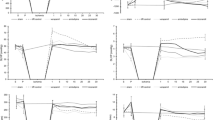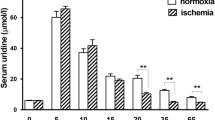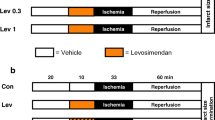Abstract
Lacidipine is a new developed dihydropyridine calcium-antagonist, showing a slow onset and long lasting-selective activity.
To assess whether the administration of lacidipine protects the myocardium in a dose-dependent manner against ischaemia and reperfusion, isolated rabbit heart were infused with three different concentrations of lacidipine: 10−10; 10−9; 10−8 M. Diastolic and developed pressures were monitored; coronary effluent was collected and assayed for CPK activity and for noradrenaline concentration; mitochondria were harvested and assayed for respiratory activity, ATP production and calcium content and tissue concentration of ATP, creatine phosphate (CP) and calcium were determined. Occurrence of oxidative stress during ischaemia and reperfusion was also monitored in terms of tissue content and release of reduced (GSH) and oxidized (GSSG) glutatione. Treatment with lacidipine at 10−10 and 10−9 M had no effects on the hearts when perfused under aerobic condition, whilst the higher dose reduced developed pressure of 36%. The ischaemic-induced deterioration of mitochondrial function was attenuated. On reperfusion treated hearts recovered better than the untreated hearts with respect to left ventricular performance, replenishment of ATP and CP stores and mitochondrial function. The reperfusion-induced tissue and mitochondrial calcium overload, release of CPK and of noradrenaline and oxidative stress were also significantly reduced. The effects of lacidipine were dose-dependent. The lower concentration (10−10 M) failed to modify ischaemic and reperfusion damage. The dose of 10−9 M was cardioprotective, but the best effect was found at 10−8 M.
It is concluded that lacidipine infusion provides a dose dependent protection of the heart against ischaemia and reperfusion. Because this protection occurred also at 10−9 M, in the absence of negative inotropic effect during normoxia and of a coronary dilatory effect during ischaemia, it cannot be attributed to an energy sparing effect or to improvement of oxygen delivery. From our data we can envisage two other major mechanism:-1) membrane protection-2) reduction of oxygen toxicity. The ATP sparing effect occurring at 10−8 M is likely to be responsable for the further protection.
Similar content being viewed by others
References
Smith HJ, Singh BN, Noris RM, Nisbet HD, John MB, Hurley PJ: Effects of verapamil on infarct size following experimental coronary occlusion. Cardiovasc Res 9: 569–578, 1975
Nayler WG, Ferrari R, Williams A: Protective effect of pretreatment with verapamil, nifedipine and propranolol on mitochondrial function in the ischaemic and reperfused myocardium. Am J Cardiol 4: 242–248, 1980
Kloner RA, Braunwald E: Review: observations on experimental myocardial ischaemia. Cardiovasc Res 14: 371–395, 1980
Kloner RA, Braunwald E: Effects of calcium antagonists on infarcting myocardium. Am J Cardiol 59: 84B-89B, 1987
Ruigrok TJC, Van Echteld CJA, De Krujjff B, Borst C, Neijler FL: Protective effect of nifedipine in myocardial ischaemia assessed by phosphorus-31 nuclear magnetic resonance. Eur Heart J 4 (Suppl. C): 109–113, 1983
Melin JA, Becker LC, Hutchins GM: Protective effect of early and late treatment with nifedipine during myocardial infarction in the conscious dog. Circulation 69: 131–141, 1984
Klein HH, Schubothe M, Nebendahl K, Kruezer H: The effects of two different diltiazem treatments on infarct size in ischaemic reperfusion porcine hearts. Circulation 69: 1000–1005, 1984
Reimer KA, Jennings RB, Cobb FR, Murdock RH, Greenfield JC, Becker LC, Bulkey BH, Hutchins GM, Schwartz RP, Bailey KR, Passamani ER: Animal models for protecting ischaemic myocardium: results of the NHLBI cooperative study comparison of inconscious and conscious dog model. Circ Res 56: 651–655, 1985
Braunwald E, Kloner R: The stunned myocardium: prolonged, postischaemic dysfunction. Circulation 66: 1146–1149, 1982
Reimer KA, Jennings RB: Effects of calcium channel blockers on myocardial preservation during experimental acute myocardial infarction. Am J Cardiol 55: 107B-115B, 1985
Crome R, Hearse DJ, Manning AS: Ischaemia and reperfusion-induced arrhythmias: beneficial actions of nifedipine. J Cardiovasc Pharmacol 8: 1249–1256, 1986
Nayler WG, Panogiotopoulos S, Elz JS, Sturrock WJ: Fundamental mechanism of action of calcium antagonist in myocardial ischaemia. Am J Cardiol 59: 75B-83B, 1987
De Jong JW, Huizer T: Reduced glycolysis by nisoldipine treatment of ischaemic heart. J Cardiovasc Pharmacol 7: 497–500, 1985
Lavenchy N, Martin J, Rossi A: Effects of diltiazem on the energy metabolism of the isolated rat heart submitted to ischaemia: a phosphorus-31 nuclear magnetic resonance study. J Mol Cell Cardiol 18: 931–941, 1986
Kirkles JH, Ruigrok TJC, Van Echteld CJA, Neijler FL: Protective effect of pretreatment with the calcium antagonist anipamil on the ischaemic-reperfused rat myocardium: a phosphorus-31 nuclear magnetic resonance study. J Am Coll Cardiol 2: 1087–1093, 1988
Drake-Holland AJ, Noble MIM: Myocardial protection by calcium antagonist drugs. Eur Heart J 4: 823–825, 1983
Chaudhry A, Vohra MM: Depletion of cardiac noradrenaline stores by the calcium-channel blocker D-600. Can J Physiol Pharmacol 62: 640–644, 1984
Chaudhry A, Vohra MM: A reserpine-like action of verapamil on cardiac sympathetic nerves. Eur J Pharmacol 97: 156–158, 1984
Higgins AJ, Blackburn KJ: Prevention of reperfusion damage in working rat hearts by calcium antagonists and calmodulin antagonists. J Mol Cell Cardiol 16: 427–438, 1984
Brezinski ME, Darius H, Lefer AM: Cardioprotective action of a new calcium channel blocker in acute myocardial ischaemia. Drug Res 36: 464–466, 1986
Carpi C, Gaviraghi G, Semeraro C: GX (GR 1048), a new dihydropyridine calcium antagonist with potent and long-lasting antihypertensive action. Br J Pharmacol 89 (Proc Suppl): 758, 1986
Heber ME, Broadhurst PA, Briagen GS, Raftery EB: Effectiveness of the once-daily calcium antagonist, lacidipine, in controlling 24-hour ambulatory blood pressure. Am J Cardiol 66: 1228–1232, 1990
Krebs HA, Henseleit K: Untersuchungen uber die karnstoffbildung im tierkorper. Hoppe-Seyler's Physiol Chem 210: 33–66, 1932
Langendorff O: Untersuchungen am uber lebenden Saugertierherzen. Pfluger's Archiv Physiol Mensch Tiere 61: 291–332, 1895
Oliver TA: A spectrophotometric method for the determination of creatine phosphokinase and myokinase. Biochem J 61:116–122, 1955
Tietze F: Enzymatic method for quantitative determinations of nanogram amounts of total and oxidized glutathione: applications to mammalian blood and other tissue. Analyt Biochem 27: 502–522, 1969
Ferrari R, Williams AJ: The role of mitochondria in myocardial damage occurring on post-ischaemic reperfusion. J Appl Cardiol 1: 501–519, 1986c
Bradford MM: A rapid and sensitive method for the quantification of microgram quantities of protein utilizing the principle for protein-dye binding. Anal Biochem 72: 248–254, 1976
Lamprecht W, Trauschold E: Adenosine-5′-triphosphate determination with hexokinase and glucose-6-phosphate dehydrogenase. In: HU Bergmeyer, (ed). Method of Enzymatic Analysis. Academic Press Inc, New York, 1974, pp 2101–2105
Peng GF, Rane JJ, Murphy ML, Straub KD: Abnormal mitochondrial oxidative phosphorylation of ischaemic myocardium reversed by calcium chelating agents. J Mol Cell Cardiol 9: 897–908, 1977
Wollenberger A, Ristan Schoffa G: Eine einfache technik der extremschnellen abkulung grosser er gewebstucke. Pfluger's Archiv 270: 3904–3913, 1960
Sedlack J, Lindsay RH: Estimation of total, protein-bound and non protein sulphydryl groups in tissue with Ellman's reagent. Analyt Biochem 25: 192–205, 1968
Ferrari R, Ceconi C, Curello S, Guarnieri C, Caldarera CM, Albertini A, Visioli O: Oxygen mediated myocardial damage during ischaemia and reperfusion: role of the cellular defences against oxygen toxicity. J Mol Cell Cardiol 17: 937–945, 1985
Ferrari R, Curello S, Ceconi C, Di Lisa F, Raddino R, Visioli O: Myocardial recovery during post-ischaemic reperfusion: effects of nifedipine, calcium and magnesium. J Mol Cell Cardiol 18: 487–488, 1986a
Ferrari R, Ceconi C, Curello S, Cargnoni A, Agnoletti G, Boffa GM, Visioli O: Intracellular effects of myocardial ischaemia and reperfusion: role of calcium and oxygen. Eur Heart J 7: 3–12, 1986b
Schaper W, Lewi P, Flameng W, Gijpen L: Myocardial steal provided by coronary artery occlusion. Basic Res Cardiol 68: 3–20, 1973
Opie LH: Calcium channel antagonists, part I: Fundamental properties: mechanisms, classification, sites of action. Cardiovasc Drugs Ther 1: 411–430, 1987
Bush LR, Li Y-P, Shlafer M, Jolly SR, Lucchesi BR: Protective effects of diltiazem during myocardial ischemia in isolated cat hearts. J Pharmacol Exp Ther 218: 653–661, 1981
Ferrari R, Curello S, Cargnoni A, Condorelli E, Belloli S, Albertini A, Visioli O: Metabolic changes during post-ischaemic reperfusion. J Mol Cell Cardiol 20: 119–133, 1988
Henry PD, Wahl AM: Diltiazem and nitrendipine suppress hypoxic contracture in quiescent ventricular myocardium. Eur Heart J 4: 819–822, 1983
Kirkles JH, Ruigrok TJC, Van Echteld CJA, Neijler FL: Protective effect of pretreatment with the calcium antagonist anipamil on the ischaemic-reperfused rat myocardium: a phosphorus-31 nuclear magnetic resonance study. J Am Coll Cardiol 2: 1087–1093, 1988
Holt WW, Wendland MF, Derucin N, Wolfe C, Saeed M, Higgins CB: Effects of nicardipine, a calcium antagonist, on myocardial salvage and high energy phosphate stores in reperfused myocardial injury. J Am Coll Cardiol 16: 1736–1744, 1990
Higgins AJ, Blacburn LJ: Prevention of reperfusion damage in working rat hearts by calcium antagonists and calmodulin antagonists. J Mol Cell Cardiol 16: 427–438, 1984
Golothwait DA: Mechanisms of synthesis of purine nucleotides in heart muscle extracts. J Clin Invest 36: 1572–1578, 1957
Zimmer HG, Trendelenburg C, Kammermeier H, Gerlach E: De novo: synthesis of myocardial adenosine nucleotide in the rat. Circ Res 32: 635–639, 1973
De Jong JW, Huizer T, Tijseen JGP: Energy conservation by nisoldipine in ischaemic heart. Br J Pharmac 83: 943–949, 1984
Williams AJ, Ferrari R: Methods of studying respiration. ATP synthesis and proton movement in cardiac mitochondria. In: NS Dhalla (ed). Methods in studying cardiac membranes. CRC Press Inc, 1983, pp 75–86
Weishaar RE, Bing RJ: The beneficial effect of a calcium channel blocker, diltiazem, on the ischaemic-reperfused heart. J Mol Cell Cardiol 12: 933–1009, 1980
Ferrari R, Boffa GM, Ceconi C, Curello S, Boraso A, Ghielmi S, Cargnoni A: Effect of D-600 on ischaemic and reperfused rabbit myocardium: relation with timing and modality of administration. Basic Res Cardiol 84: 606–622, 1989
Sperelakis N: Cyclic AMP and phosphorylation in regulation of Ca influx into myocardial cells, and blockade by calcium antagonist drugs. Am Heart J 107: 347–357, 1984
Nayler WG, Sturrock WJ: Inhibitory effect of calcium antagonists on the depletion of cardiac norepinephrine during post-ischaemic reperfusion. J Cardiovasc Pharmacol 7: 581–587, 1985
Mak II, Beglicki WB: Comparative antioxidant activities of propranolol, nifedipine, verapamil, and diltiazem against sarcolemmal membrane lipid peroxidation. Circ Res 66: 1449–1452, 1990
Hess ML, Okabe E, Kontos HA: Proton and free oxygen radical interaction with the calcium transport system of cardiac sarcoplasmic reticulum. J Mol Cell Cardiol 13: 767–772, 1981
Ceconi C, Curello S, Albertini A, Ferrari R: Effect of lipid peroxidation on heart mitochondria oxygen consuming and calcium transporting capacities. Mol Cell Biochem 81: 131–135, 1988
Author information
Authors and Affiliations
Rights and permissions
About this article
Cite this article
Boraso, A., Cargnoni, A., Comini, L. et al. Effect of lacidipine on ischaemic and reperfused isolated rabbit hearts. Mol Cell Biochem 125, 73–86 (1993). https://doi.org/10.1007/BF00926837
Received:
Accepted:
Issue Date:
DOI: https://doi.org/10.1007/BF00926837




